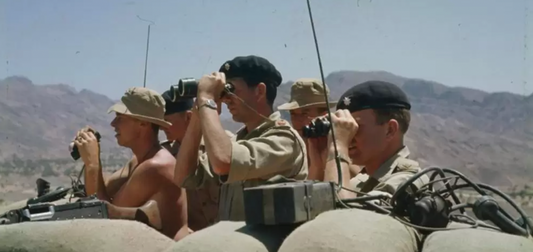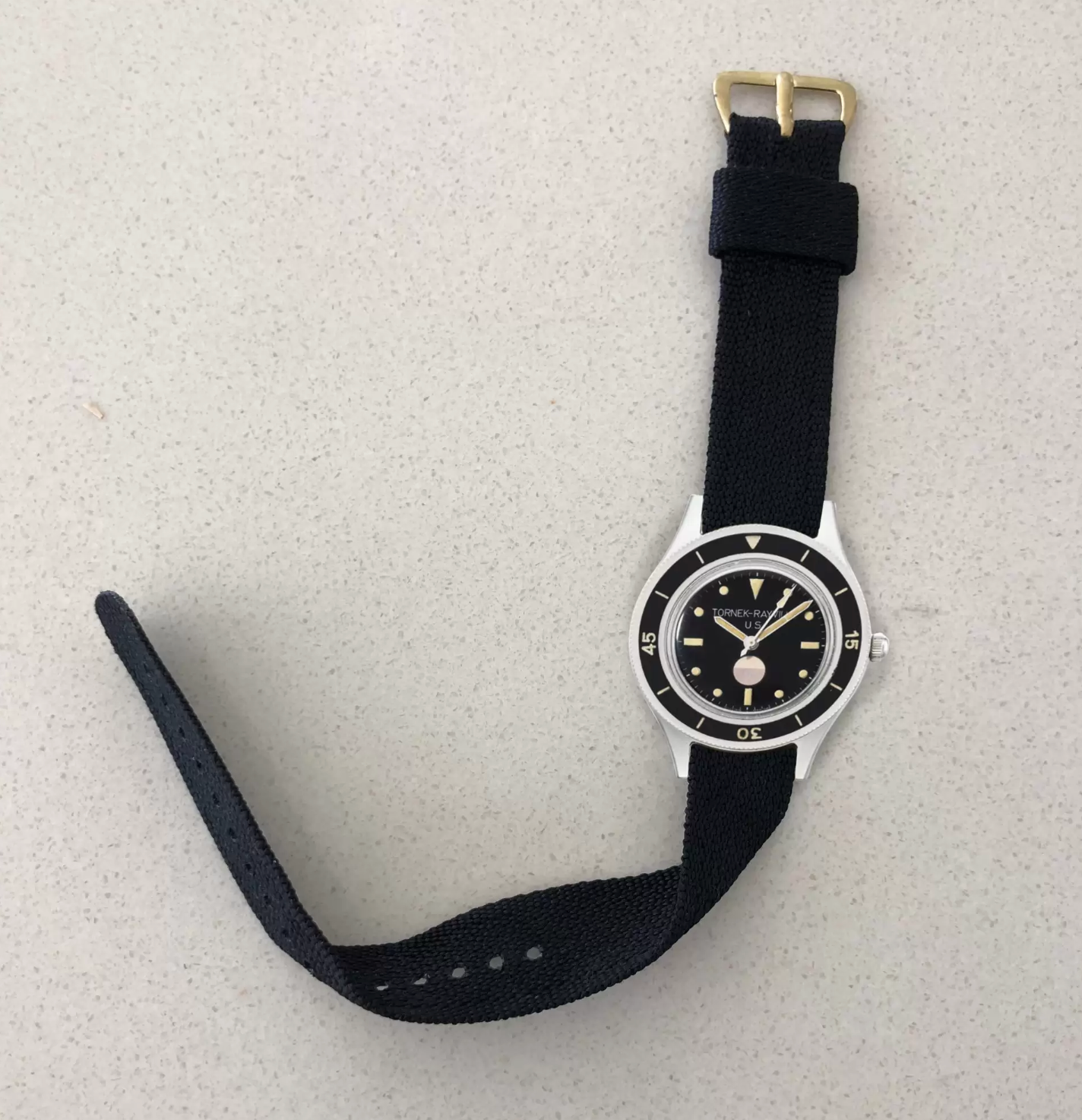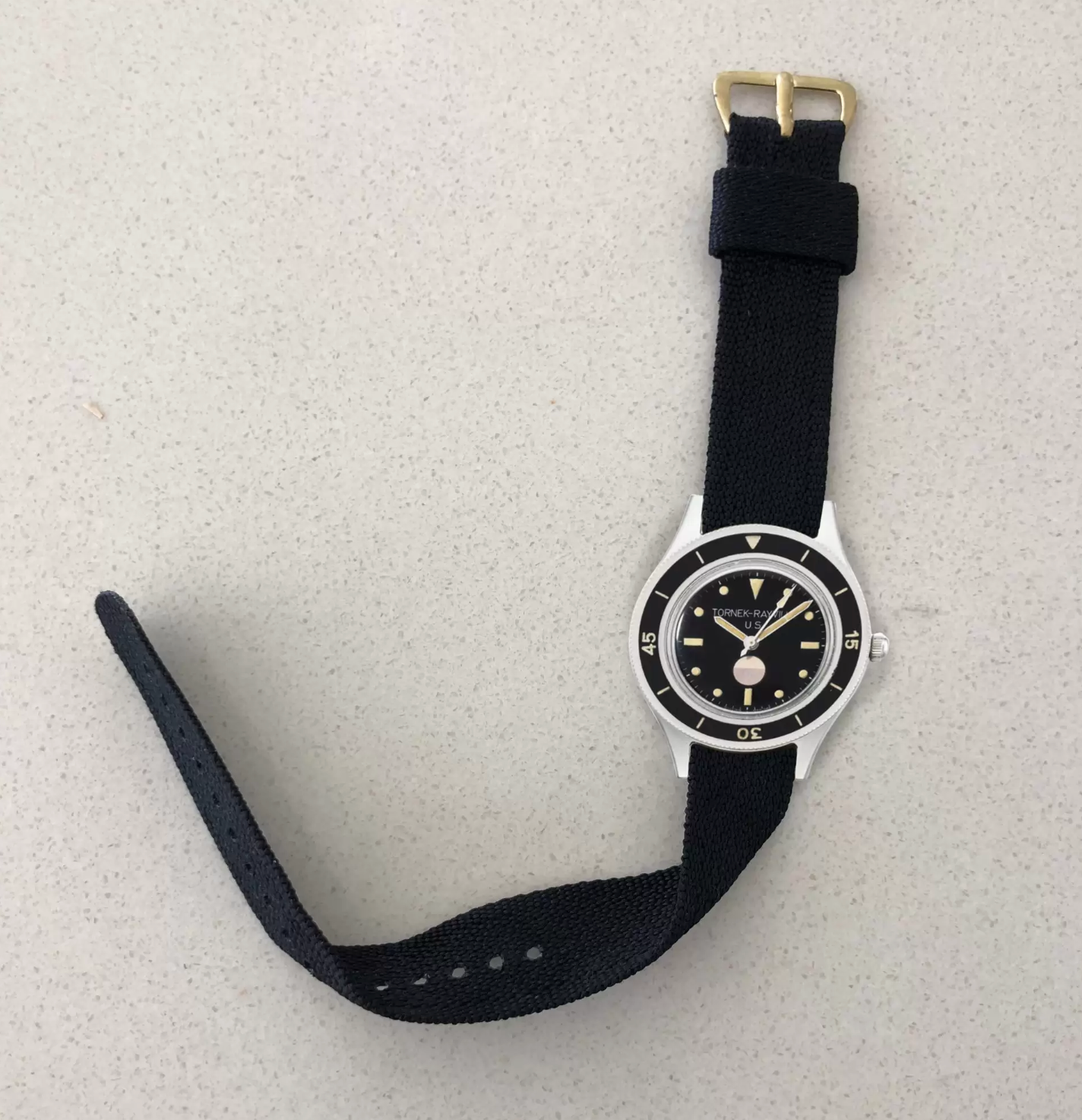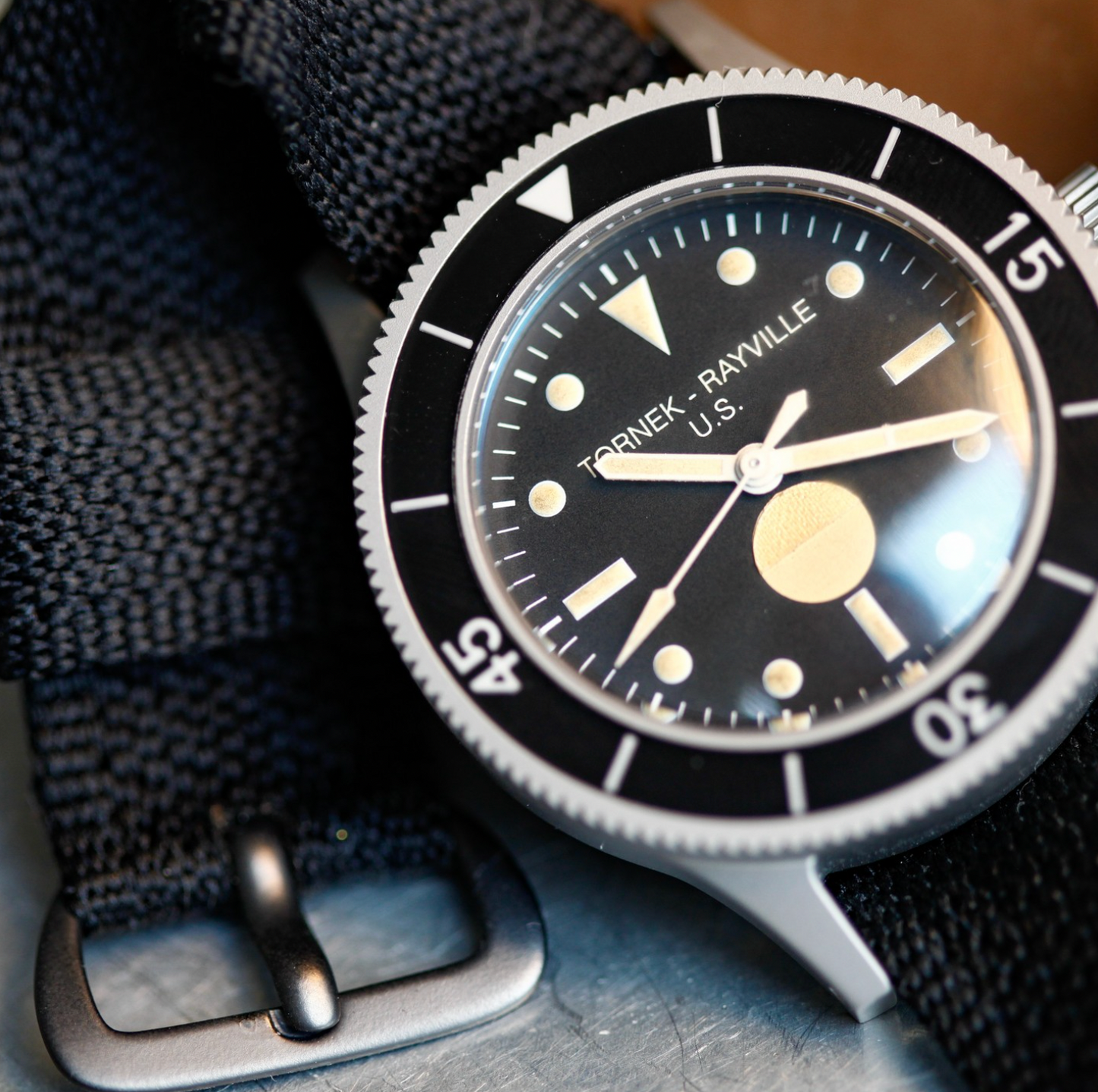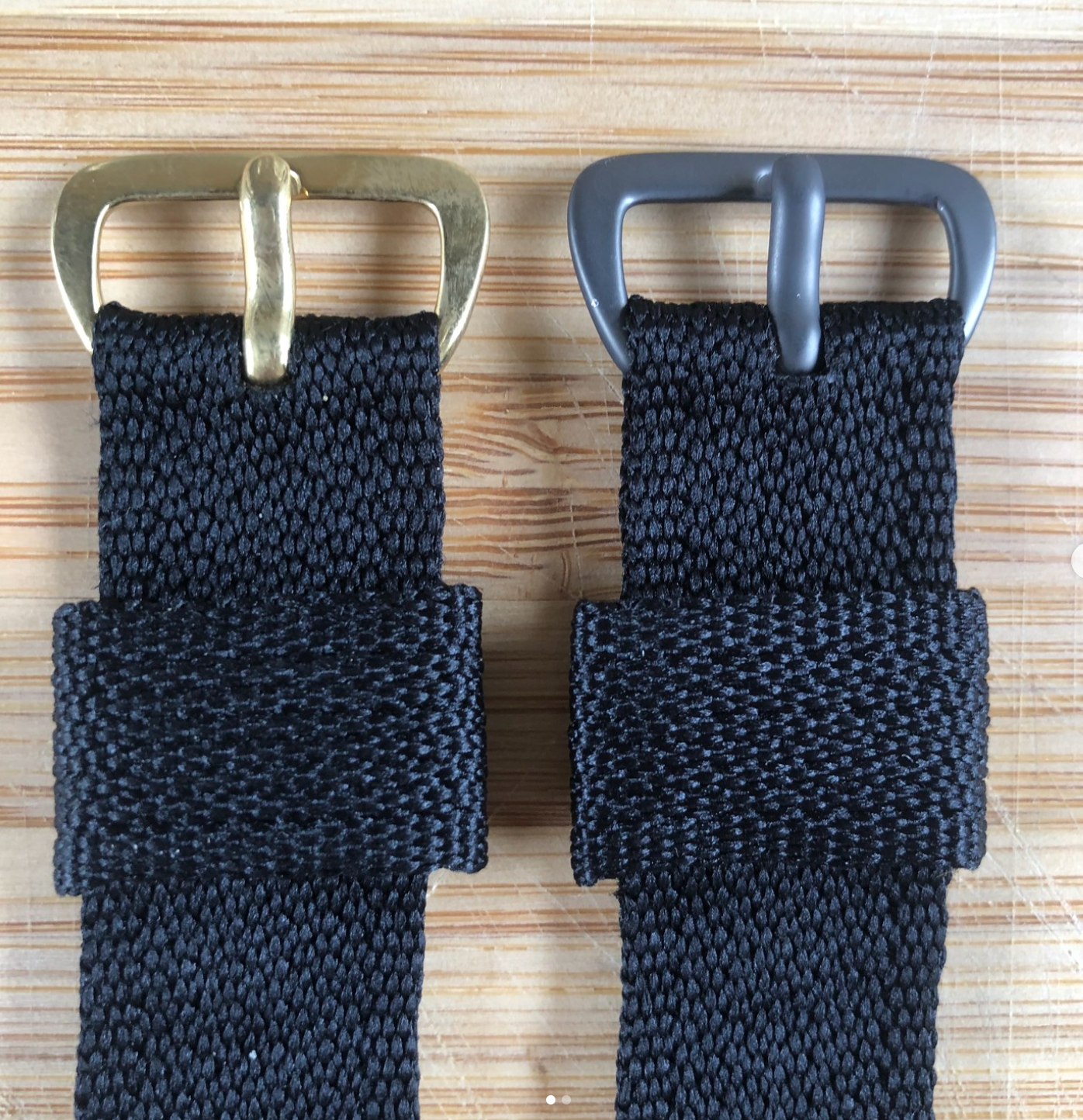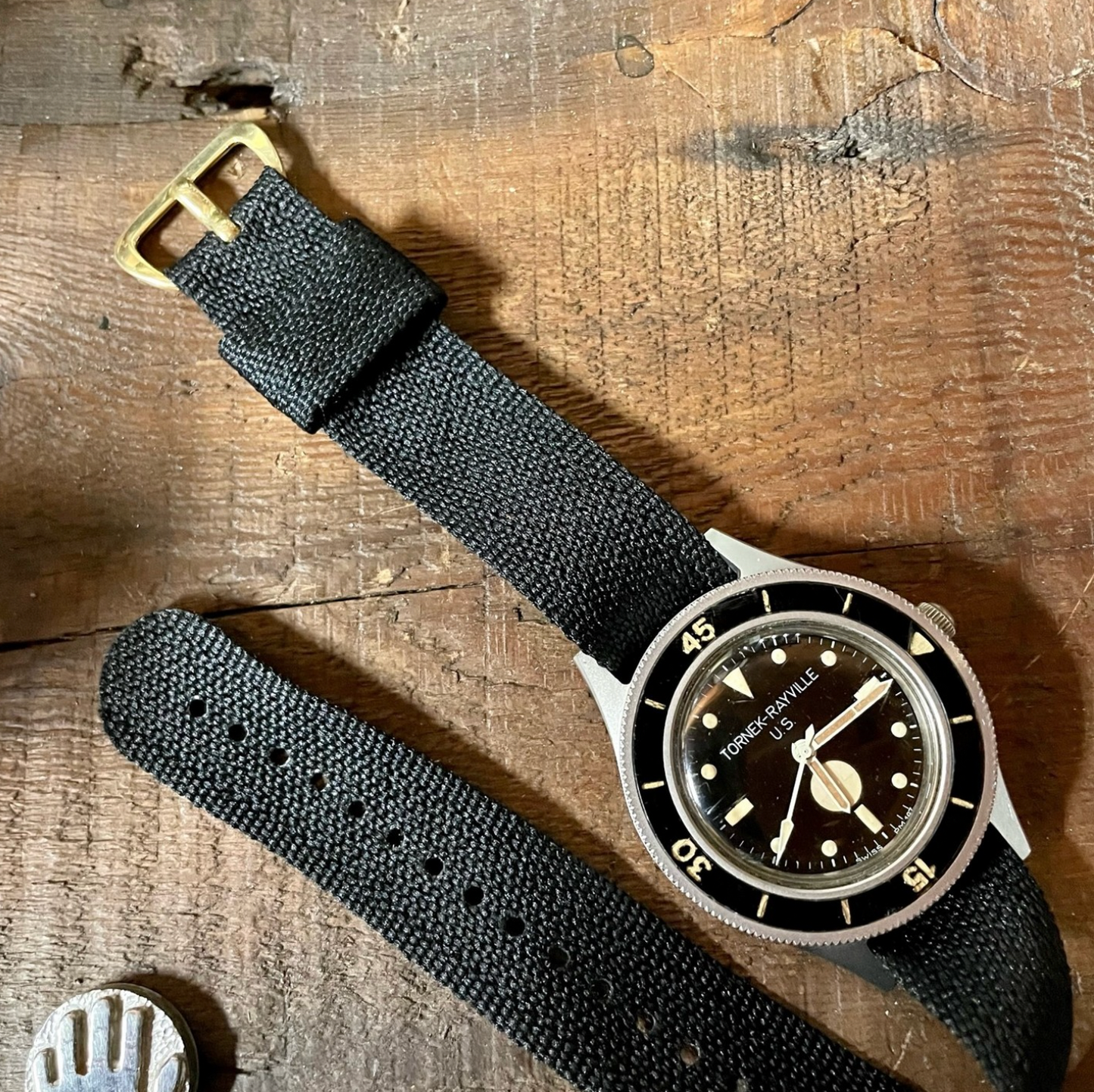THE NATO WATCH STRAP IN THE WW1 ERA
Some would argue that the NATO watch strap did not exist in WWI, but in fact, their grandfather straps were in existence prior to, and after, WWI.
The development and history of the NATO watch strap is part of the evolution of the military watch. Watches were a critical requirement for military manoeuvres and the wristwatch was essentially spawned, and became prevalent, in WWI.
We take the availability of the correct time for granted, but in 1914 things were very different. A 1000 man battalion of the British Expeditionary Force in WWI would have had only eight GS (General Service) pocket watches issued. One to the Signalling Sergeant and the others to be shared among 16 Signallers. Officers were not equipped with pocket watches by the Army but were required to provide these themselves, and often they chose watches with wristlets. Coordinating operations in these circumstances would have been difficult.
The H. Williamson watch below was one GS issue. These watches were retrospectively designated GS watches in July 1929 when the GS MkII watch was introduced, and they were declared obsolete. Few, if any, were engraved GS; rather they carried the pheon and an inventory number.

Because of the lack of what proved to be an essential item in the trenches, contemporary advertisements urged family and friends at home to send a watch or wristlet watch to the front, as in the advertisement below for Waltham wristlets in silver cases, which says “So send me the very best you can buy…”

IMAGE CREDIT MWR FORUM USER: BOBBEE
The first consistent use of the word wristwatch in newspapers was in 1915, and prior to that the word wristlet was more commonly used to distinguish wristlets from pocket watches and to describe leather pocket watch straps.
In the 1916 book entitled “Knowledge for War,” the recommended Officer’s Kit commenced with a luminous wrist watch with unbreakable glass.


This article traces the roots of the military development of the NATO watch strap from the leather wristlet.
PRE WWI
Below is a 1901 advertisement for wristlets “For the Tourist, the Bicyclist, the Soldier”. The use of wristlets had developed in the late 1880’s, and these and bracelets were more common for ladies watches, but to tell the time on a bicycle with a pocket watch would have been difficult. This led to the use of wristlets for pocket watches, to be used by men and women when on a bicycle.
The 1893 advertisement from Henry Wood and Co in London shows that the habit of clipping a pocket watch to the bicycle was fraught with danger. Cycle racing required accurate stop watches.

Image courtesy MWR forum user: bobbee
The 1890’s development of the bicycle into a safe form of transport led to a bicycle craze in America which peaked in 1896 and was then exported to Europe. In this era before motor vehicles, the New York Tribune in 1895 asserted that the bicycle was “of more importance to mankind than all the victories and defeats of Napoleon, with the First and Second Punic Wars . . . thrown in.”

Wristlets could be bought in a variety of leather types, as in the 1901 advertisement above. The pocket watch strap above is a Garstin type strap.
The Elfina advertisement from 1896 below shows a ladies bicycling watch in a looped pouch, in effect a leather lugged watch. For extra security, this style of strap only required one lug at the base of the pocket watch.

An Omega advertisement from 1911 shows a wire lugged watch with a leather pull-through strap. Some of the early bracelet watches had the crown at 9 o’clock as shown in the advertisement. Outdoor activities and the army were targets of the advertisement.


A 1910 Omega with the crown at 9 o’clock, marked depose 9846 is shown below the advertisement. Dimier Frères & Cie patented watches with handles on 29 July 1903. It was depose (patent number) CH9846. The patent showed a strap identical to that in the advertisement.
The advertisement below shows a leather pull-through strap on a watch with lugs.

THE GARSTIN AND OTHER WRISTLETS
The wristlet shown in the 1901 advertisement history above is similar to the current NATO watch strap. However, a further refinement by Garstin increased the likeness.
The leather goods retailer Arthur Garstin registered the design below with the British Board of Trade. The date of registration of this wristlet design RD 217622 was 2 September 1893, but the wristlet would have been in production prior to this. The strap B passed through the eyelet A to hold the pocket watch in place by lifting up the backing strap.



Whether the design stemmed from the development of the safety bicycle, or from use by the British Empire forces in India or on the Northwest Frontier between 1885 and 1887 is unclear.






The new tennis scorer was also registered 20058 on 2 October 1893, but obviously proved unpopular, and has disappeared without a trace.
The ladies wristlet, RD 70068 bottom left in the advertisement above, is shown below. In this design, the strap has a pouch which holds the watch to a backing strap.

Below is an 1893 advertisement for the “Skirmisher” by Mappin Brothers. It features a Garstin type wristlet with a wider strap. The backing leather extends from where the pouch is sewn on, to the buckle. After the first Boer War, the watch was no longer necessary for officers to time troop movements, so it could be used for hunting, yachting, and cycling,……

The second Boer war (1899-1902) contributed to pocket watches being used in a leather pouch worn on the wrist.
The 1901 Mappin and Webb’s advertisement for the ‘Campaign’ watch followed on from the Skirmisher advertisement. Mounted in a Garstin type wristlet, the advertisement below urged family and friends at home to send a solid leather wristlet watch to the front. It read “Delivered at the front duty and postage free for an additional 1 s. (shilling) each.”

1901 Mappin and Webb’s advertisement in the “Illustrated Sporting and Dramatic News” 7 September 1901. “Reliable timekeeper under the roughest conditions”.
Below is an Omega advertisement for a military safety watch with a leather strap which will “hold and protect the watch during the roughest riding and most violent exercise.” The watch was in a pouch held by a press stud so that the watch could be removed from the wrist without removing the strap. Omega used the term wrist watch, but this did not fall into common use. The “6” size wristlet was for men, and the “O” size wristlet was for ladies.

Following on from the Boer War, leading into WWI other manufacturers also produced leather wristlets.
Nurses and automobiling were additional to cycling and general use as wristlet targets.

Image courtesy of Watchuseek user : AbslomRob
Above is an advertisement by the Canadian department store Eaton from 1908. At the turn of the century they often used Waltham watch movements as their in house brand. The wristlet was aimed at “nurses, automobiling, cycling and general use”, not the military. The design was an adaption of the Garstin design with a wider strap passing through a slot, holding down the pouch, and the buckle at 6 o’clock. Wristlets were available in hide for 25 cents, pig skin 35 cents, seal or morocco leather 50 cents, or alligator or walrus for 75 cents.
THE DIMIER STRAP
There has been much debate and controversy about the date and make of the first wrist watch. Certainly in 1890 in Switzerland wrist watches were themselves causing debate. The Federal Department of Foreign Affairs, Trade Division, wrote to the authorities for assay of articles of gold and silver concerning wrist watches:
“Berne, January 10, 1890.
Gentlemen,
The question we were asked was whether and on what conditions wrist-watches may be subject to hallmarking; this question requires detailed study due to the fact that objects of this kind are at different times categorised as objects of jewellery and as objects of watchmaking, and that these two categories of objects are, regarding hallmarking, subject to different requirements.
We have the matter under review; at such time as it is completed we will let you know the decisions we have taken to address the issue. In the meantime, we have asked the control authorities to cease hallmarking (this applies to both at the present time):
a. watch cases destined to be mounted in bracelets;
b. bracelets which it would be possible to attach to watch cases after their passage through control.”
However, whether hallmarked or not, it is certain that a wristwatch design with wire lugs was patented by Dimier Frères & Cie (called watches with handles) on 29 July 1903. It was deposed (patent number) CH9846. At the same time, they illustrated a leather strap with a circular midsection to fit behind the watch. The crown of the watch in the illustration is at 12 o’clock.

IMAGE COURTESY: DAVID BOETTCHER OF VINTAGE WATCH STRAPS
This design required the buckle to be sewn into the strap after fitting to the watch. To avoid this, a special buckle, which they later registered in 1907, had to be fitted to the strap after it was threaded in each direction through the wire lugs of the watch.

Below is a depose 9846 enamel dial wire lug watch, hallmarked history dated to 1905, with the movement marked DF&C (Dimier Freres et Cie), with the crown at 9 o’clock and an open-ended leather NATO watch strap.

The Elgin wrist watch (heading) or strap watch (text) advertisement from 1913 shows a Dimier strap and buckle on an Elgin watch, designed for active men.


IMAGE COURTESY: DAVID BOETTCHER OF VINTAGE WATCH STRAPS


In this 1917 Omega advertisement, the widening of the Dimier strap behind the watch can be seen. The watches are encased in a hermetic box (still labelled depose 9846) for protection and feature a radium option for an extra 12 to 15 francs.


Below is the watch in the advertisement above, case stamped depose 9846.

IMAGE COURTESY OMEGA FORUM MEMBER: TIRE-COMEDON
By the time of WWI, there were patents for both wristlets, and wire lugs (watches with handles), and the history of the seed had been sown for the future NATO watch strap, but the use of watches on the wrist, although popularised by the 1990’s bicycle craze was not common, especially among men.
Below is an extract from the Swiss Federation Horlogere bulletin No. 103 of 31 December 1924 which shows that in the first 11 months of 1913, the year before WWI, 11.27 million pocket watches were exported from Switzerland, and in addition 210,404 wrist watches (montres bracelets) were exported. Watches with wrist bands were only 1.6% of the Swiss export production.
This small percentage of the finished watch market ignores the fact that another 2.18 million watch cases were also exported, for other manufacturers to add movements.

WWI led to the more prevalent use of watches on the wrist.
WWI ERA POCKET WATCH STRAPS
At the time of WWI, wrist watches were de rigueur street wear in London if the Macy’s wristlet watch advertisement of 1912 is to be believed. They were soon to be required in great numbers for a monumental outdoor activity, but in truth, virtually only pocket watches existed at the time of WWI.

THE LEATHER WRISTLET
Below is a Garstin pouch, which was typical of the way in which pocket watches were used in WWI. The 579D specification below is virtually identical.

Some pocket watches were issued to troops, and in recognition of the need for these to be worn on the wrist, in 1916 a military specification was developed based on the Garstin strap, for what became history by the end of the war as a watch strap. Made of pig skin 11 inches long and 1/2 inch wide, tan in colour, with a hinged brass circular holder 1 and a half inches diameter, with sheepskin inside, and pigskin glued on the outside, with a black oxidised brass buckle. The buckle was at 6 o’clock.
The Official Specification for Movements, Cases and Straps, General Specification 579D, of 24 October 1916 read :
“6 Wristlet – A wristlet shall be furnished with each watch. This wristlet shall be made of single-ply genuine pigskin and shall be of the dimensions and made up as shown upon drawing.”
The first version in the history of the NATO watch strap had been specified by the US military.

Image credit MWR forum user: bobbee
Below is a pouch strap which had a shrapnel guard to protect the watch face, and a leather pouch to help hold the watch and guard in place. The pouch is removable, and together with its contents is effectively a leather lugged pocket watch, as seen in the 1896 cycling advertisement above.

Image courtesy Vintage Watch Forums user: Findingtime

Above is a leather lugged pocket watch converter made by the Western Leather Manufacturing Co. of San Francisco.
THE DAPTABEL
The Daptabel, patent 22449/10 by John Smith for an “expanding watch wristlet”, was a conversion device to allow pocket watches to be worn on the wrist. While various concertina type devices existed prior to the patent in 1910, this was a simple two-part strap which allowed 2 metal hooks to slide and grip a pocket watch as the strap was buckled up. The strap was 21cm long, and the buckle was at 6 o’clock. Daptabel was stamped on the cross member in either capitals or script, and patent 22449/10 was stamped on the tongue.

Below is a similar sprung conversion device, perhaps a variant of the Daptabel.

IMAGE COURTESY: CHRIS BALM
THE ALLEN
Charles Allen on 18 September 1918 patented a watch holder for pocket watches. The watch strap is shown schematically in the history patent below.
THE ROSENTHAL
The Rosenthal watch wristlet clip was a later US patent, from 6 November 1917, similar to the Daptabel clip. As wrist watches developed, this patent was not too late to be of commercial value, for as can be seen from the table at the start of this article, even in 1924, the Swiss export statistics for finished watches, showed wrist watches had only climbed to 37% of the market.

OTHER CONVERTERS
In 1909 Blacklock registered a bakelite converter which fitted over a pocket watch. A similar metal converter is shown below, allowing a strap to be passed through the lugs.
 .
.
Other unknown brand converters existed, a spring loaded clamp being shown below.

THE WIRE LUG WATCH
Dimier Frères & Cie patented watches with handles on 29 July 1903 in depose (patent number) CH9846. The subsequent Omega wire lugged watch with the crown at 9 o’clock (in section “Pre WWI” above), and the Waltham advertisement below which shows a wire lug watch with a two-part webbing strap riveted into place, and the crown of the watch at 3 o’clock, indicating that wire lugs were not a design afterthought by about 1910.

IMAGE COURTESY MWR FORUM USER: SCOUTMEDIC
Ingersoll had the capacity to manufacture large numbers of wrist watches and advertised these from 1909 onwards. Their name wrist watch did not catch on immediately. The advertisement below in 1913 is targeted for “outdoor folks” and “husky sportsmen”. Also, they state “Uncle Sam endorses and recommends the wrist watch for his army and navy.”

A typical officer’s pocket watch was the Mappin and Webb’s Campaign watch as seen already above. Now, in 1914, it was a trench watch, which was essentially a pocket watch with wire lugs, but with the crown at 3 o’clock, and was still sold to the public with delivery to the front available for an extra shilling. The dial is signed MAPPIN and “CAMPAIGN”.

IMAGE COURTESY: THE-SALEROOM.COM


IMAGE COURTESY: GOLDSMITHWORKS.COM


IMAGE COURTESY WATCHUSEEK FORUM USER: SIGCOLLECTOR

IMAGE COURTESY: GOLDSMITHWORKS.COM

ANOTHER SOLUTION WAS THE SCREW IN RETAINER AS ON THIS 1914 GEORGE STOCKWELL CASED MARVIN SA WATCH.
WWI ONE PIECE STRAPS
THE PERSHING STRAP
The Pershing strap was the simplest design. It was a 9/16 inch wide olive drab waterproof webbing pull-through strap which had a crimped metal tip and a patented buckle. This buckle made the strap infinitely adjustable, without the need for eyelets in the webbing.

THE STEVEL WRISTLET

THE KITCHENER STRAP
The Kitchener strap provided a wide backing to the 12mm pull-through strap, and this was a very popular solution to prevent both sliding and twisting and to provide some isolation for the watch. Below is a Hirsch advertisement which shows the styles.

Below is an Illinois Kitchener watch advertisement from 1917.
Leather Kitchener (and Bund) style watches were common throughout WWI, continuing to the present, and could be easily produced by any saddler.
Although not the subject of this article, this style was also the grandfather of the NATO Bund strap NSN 6645-12-145-6415.
ONE PIECE INFINITELY ADJUSTABLE STRAPS
In America, WWI led to a number of patented one-piece straps for wire lug watches. The strap was looped over one wire lug, passed through the other lug, and then tightened and clipped into place. This allowed an infinite range of adjustment. The “D-D” No Fuss Strap is discussed first, as it is the most widely advertised model.
THE ‘NO FUSS’ STRAP
Depollier produced a “D-D” Khaki Watch, with a Waltham movement, and a “No Fuss” Ordinance Department webbing strap in mid-1917. D-D stood for C.L. Depollier and E. C. Duncuff. The watch strap could be adjusted to any size as it had a patented clamp (July 25, 1916). The clamp was removable and could be engraved as shown in the advertisement below. In history by 1918, the NATO watch strap width had increased to 3/4 inch, which both reduced twisting, and also allowed more room for engraving on a wider clasp.
The perceived benefits of the “No Fuss” strap are explained below. These would apply to any similar looped strap. (The B-Uhr watch issued in WWII had a looped leather strap to prevent accidentally dropping the watch).



WALTHAM IMAGES COURTESY MWR FORUM USER: MR.D




The “No Fuss” clasp is shown above. It was removable as seen in the top advertisement, and fitted into the loop of a replacement strap. The strap was Cravenette treated (a waterproof process invented by the Bradford Dyers Association) webbing and cost 35 cents to replace, the same price as a leather strap.



DEPOLLIER WATCH ADVERTISEMENT WITH A KHAKI STRAP.
THE SIMPLEX STRAP
The Simplex strap was quite simple, an S-shaped clasp made it the only military strap with a one-piece buckle. Pulled tight and clipped on, it allowed the strap to fit any wrist.
THE LIBERTY STRAP
The Liberty Khaki quick action strap came on Gruen military watches. The thin slider could be passed through the wire lugs and once the webbing strap was looped on one wire lug, it could be pulled tight and used to make any watch fit tightly.


THE J.F. STURDY STRAP
The US fastener by J.F. Sturdy and Sons is shown below left, probably having survived the war because of the gold plating. This watch strap could be fitted to any watch, and the US tab fitted into the horns of the slider, providing infinite adjustment.


Left-hand Image courtesy Vintage Watch Forum user: Literustyfan, Right-hand image courtesy : Stricklandvintagewatches.com
Below is a 1918 Patria watch in a Fahys shrapnel case, with a J.F. Sturdy and Sons strap.


Images courtesy: Stricklandvintagewatches.com

DEPOLLIER WATCH ON U.S. STRAP
THE VICTOR SENCE STRAP
Patent 8 October 1918 no US1280877 for a wrist watch fastening by Victor Simon Sence states :
My invention relates to fastening means for the loops or bands used to secure wrist watches upon the person of the wearer and presents a simple, readily detachable and adjustable device for holding the free end of the band which is usually looped around the wearers-wrist, passed through an ear upon the watch case and then doubled back for attachment to an intermediate portion of said band.
A device of this character must be easily and quickly attachable and detachable by the free hand of the wearer, and easily-adjustable to wrists of different sizes. It should also be simple and free from moving parts which would be apt to break or get out of adjustment under conditions existing on a battle front. My present invention attains these objects and certain, advantages hereinafter to be set out.

This had a cam like action to clamp the strap end to the slider, to provide infinite adjustment.
THE STRONGHOLD STRAP
The Stronghold strap, a July 16 1918 patent, was able to be attached instantly without fuss or bother, as the clasp had 2 hooks for attaching it to the watch strap, and is another variation of the press-fit strap.

The press fit clasp is shown below and presses onto 2 horns mounted on a slider.



Image courtesy Stan Czubernat: LRFAntiqueWatches.com
THE WALTHAM BRACELET
The Waltham bracelet is shown below on a Waltham Cadet watch which had punched stainless lugs.
This NATO watch strap could be looped through one lug, and the clasp hooked onto a slider. The advertisement dates to 1922, so this bracelet may never have featured in WWI. Again, it is but a slight variation on the J.F. Sturdy strap.

Image courtesy Watchuseek user: Literustyfan
THE PERSON STRAP
A. Person patented a buckle on 20 November 1917 for a hinged clasp on a sliding strap.

THE FAHEY INTEGRATED SHRAPNEL PROTECTION WATCH CASE CAME WITH A PERSON STRAP BUCKLE WHICH CLIPPED OVER LUGS PROTRUDING FROM THE SIDES OF THE SLIDER.

Image courtesy: Stricklandvintagewatches.com

A Waltham with a shrapnel protector on a Person buckle strap.

A 1919 ADVERTISEMENT FOR A HAMILTON 981 WATCH ON A PERSON KHAKI STRAP.
A SLIDING CLIP
This clip slid over two horns locking it into place.

IMAGE COURTESY: STRICKLANDVINTAGEWATCHES.COM
Another sliding clip is shown below on a woven strap fitted to an early watch with handles, still with the crown at 12 o’clock.


THE CLIMAX/VICTOR STRAP
E.J. Pearson and Sons became the largest strap maker in England. They registered design number 529337 with the British Board of Trade on 27 August 1908. The design is below.
This was the first NATO strap, a strap with a second flap to retain the watch.
A range of names, Simplex, Climax, Victor, and Premier were used for various versions of the NATO watch strap.



IMAGE COURTESY MWR FORUM USER: BOBBEE




COURTESY BM COLLECTION, ITEM NUMBER: 1983,1012.153.











VICTOR STRAP WITH A SPRUNG DAPTABEL ADAPTOR HOLDING A POCKET WATCH.

PEARSON STERLING SILVER BUCKLE.
At the end of WWI, the term wristwatch was in common use, but the wrist watch, particularly in America was not commonly used by men, even by returning servicemen.
It was only in the late 1920s that wrist watches gained popularity in America.
For comparison of lug and strap width, a WW2 watch, the Reconvilier ATP, is shown on a Victor strap below.

THE SPRING BAR IN WWI
In the search for a workable strap for wire lug watches, C.L. Depollier and E. C. Duncuff, had earlier in 1916 patented history the “No Fuss” NATO watch strap and clasp. However, the market still was focussed on pocket watches. They sought to dispense with the wire lug on a pocket watch and patented fold-away lugs for a pocket watch (Figure 4) and the spring bar as shown below in Figure 8, on 15 August 1916.

The patent showed fold away fingers or lugs on a pocket watch.
The patent read:
The fingers f are adapted to receive between them and to engage a bar to which the ribbon, either sautoir or wrist, or, it may be, a chain or bracelet, is connected. Preferably such bar g is made as a compression bar, comprising two telescoping members g1 and g2 with an interposed spring g3 tending to extend the bar and with a pin and slot connection g4 to limit such movement. Each outer end of the bar is provided with a projecting pin g5 to enter a corresponding recess f3 formed in the inner face of the corresponding finger f, as clearly shown in Fig. 4. The ribbon c may be connected to the bar by looping and stitching in an ordinary manner, as indicated in Figs. 1, 2 and 3, or the bar may be provided with a loop or eye g6, as shown in Figs. 6 and 7, for engagement with a snap ring or hook.
It will be obvious that when the watch is to be worn as a wrist-watch, on a ribbon, the opposite pairs of opposed fingers are extended and engaged with the wrist ribbon.
Still convinced of the popularity of the pocket watch, Depollier also patented detachable lugs for pocket watches in 1917. This allowed a thinner case than the prior patent, with hinged adapters Fig 5 and 7, which fitted over small lugs c. One adapter was a looped lug, and the other a hinged spring bar (Fig. 6)

By the time of the end of WWII watches with lugs were common, and spring bars were patented, but pocket watches were still worn by men. As the Swiss export table in the earlier section shows, even in 1924, the swiss watch industry was exporting nearly 2 pocket watches or movement cases, to every wrist watch. But in 1930 the Swiss pocket watch and wrist watch export numbers were 6.2 million each.
HISTORY CONCLUSION OF NATO WATCH STRAP
By the end of WWI, the future use of spring bars had just been patented, but not implemented. Watch straps were still focussed on fixed lugs and wristlets on pocket watches.
Forebears of the NATO “Straps, Wrist, Instrument” category, both the NATO Bund strap NSN 6645-12-145-6415, and the NATO nylon strap NSN 6645-99-124-2986 had been inactive military use.
The Tulsa World proclaimed on April 23, 1919 that the wrist-watch was here to stay.
“The war has made the world safe for men who wear wrist-watches. A red-blooded masculine person today can appear on the streets, wearing a wrist-watch without the danger of incurring a sneer or a brick. Before the war, the wrist-watch was a badge of effeminacy. The man who affected one was looked on as a fop, a simp or a sissy.”
The only question now was, what strap to wear it on.
THE GRAIL
This article is on WWI era NATO strap history, and so the grail strap has to be the E.J.Pearson and Sons Victor, the granddaddy of the NATO strap.
The Victor Reg. No. 529336 provides all the necessary DNA to the NATO Nylon strap NSN 6645-99-124-2986.
The grail strap, a NOS Victor model 529336 below is 205cm long and 9mm wide.


Here it is on a silver watch with shrapnel guard.

Image courtesy: Auckland War Memorial Museum
CREDIT
Credit for the featured image is HOROLOGIST007. He and two other users of Watchuseek, bobbee and Literustyfan have a wealth of knowledge on this subject which I have tried to draw together from the history and perspective of the NATO watch strap. David Boettcher of Vintage Watch Straps also has considerable expertise. If I have failed to give them specific credit for their images which are in the public domain, I apologise, but I could not have written this article as quickly without their enthusiasm for the watches of the period, if not the straps.













